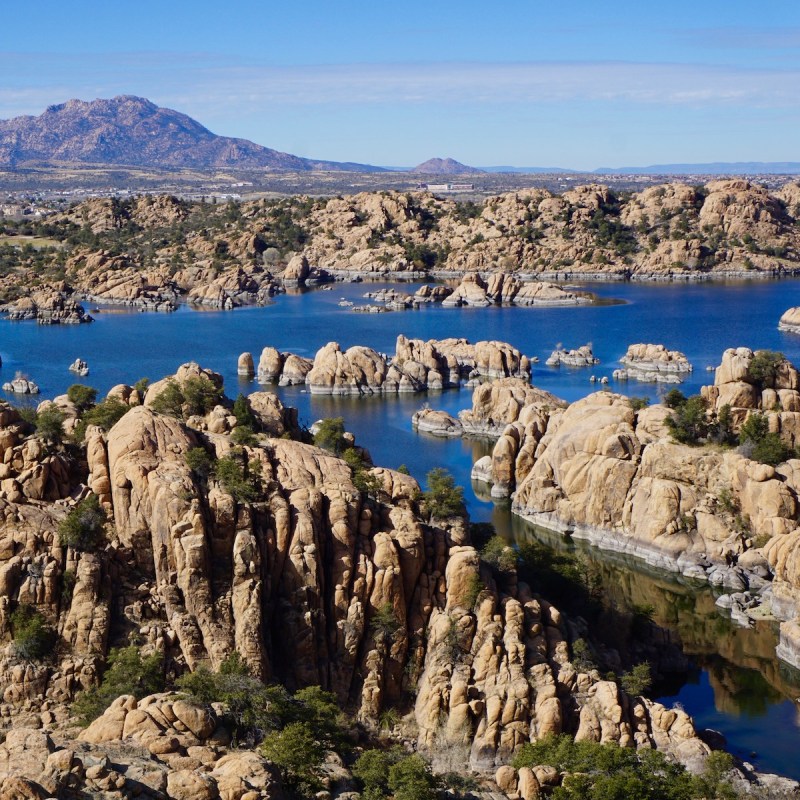
Depending on the season and the light, the granite formations at Arizona’s Watson Lake can glow a ruddy brick-red color, a delicate salmon pink, or a rich tan. Regardless of the hue, though, the lake is sure to be flat out gorgeous.
Videos by TravelAwaits
Watson Lake packs an enormous punch in the scenery and recreation arenas despite its relatively small size. The reservoir in the north-central Arizona city of Prescott is known throughout the state for the striking granite formations that surround it and dot its surface.
In fact, thanks to its picturesque qualities, the lake has become a bit of a social media sensation. Whether the granite is covered with a dusting of winter snow or glowing in the bright Arizona sunshine, Watson Lake is guaranteed to be an Instagram standout.
It is also a magnet for recreational uses, from biking to hiking to boating to fishing. As a long-time resident in the area, I have hiked around Watson Lake in every season, and I still sometimes come upon beautiful areas or seasonal marvels that take me by surprise.
Based on my many hours spent happily exploring it, here are 9 reasons you are sure to fall in love with Watson Lake.

1. The Granite Formations Are Luminous
Watson Lake is the star of the area known as the granite dells, an area of large, rounded granite boulders northeast of Prescott.
The manmade lake was created in the early 1900s with the construction of a dam on Granite Creek. For decades, Watson Lake served as a reservoir for irrigation of farmland to the north before the city of Prescott bought it in the late 1990s as a recreational and water-storage asset.
When the sun shines just right, the lake water turns a sapphire blue — a perfect complement to the orange-colored rocks. And frequently, the sunset turns the rocks a radiant pink.
Pro Tip: Watson Lake isn’t the only beautiful lake in the Prescott area. Just a few miles away is Lynx Lake, a jewel of a lake in a forest setting. Watson and Lynx are among 9 Gorgeous Lakes To Explore In Arizona.

2. It’s Beautiful In Every Season
At an elevation of just over 5,000 feet, Prescott enjoys all four seasons, with sometimes snowy winters, warm springs, hot summers, and crisp autumns. Watson Lake shines in all of them.
The occasional big winter storm can turn the area around Watson Lake into a winter playground, attracting snow hikers, adventurous kayakers, and even cross-country skiers.
Springtime brings warm, breezy days, budding trees, and clusters of flowering hedgehog cactus, while summer is a time for hot days and monsoon rains that bring the sound of running water to the washes in the dells. Autumn is perhaps the loveliest season of all, with the stands of cottonwood trees turning to gold against the granite backdrop.

3. A Historic Rail-Trail Borders It
Running along the east side of Watson Lake is the Peavine National Recreational Trail, one of Arizona’s few rails-to-trails projects. The trail follows the route of the 1890s-era Santa Fe Railway line that threaded its way through the towering granite rock formations known as the Point of Rocks.
Today, the Peavine offers a close-up look at the rocks, as well as Watson Lake’s lovely coves. It is among Prescott’s most popular trails, annually attracting thousands of bicyclists, hikers, horseback riders, joggers, and parents pushing strollers.
Along with its exceptional scenic qualities, the Peavine also has plenty of history surrounding it, and it is one of 7 Historic Trails Not To Miss In Arizona.
Pro Tip: The Peavine Trail connects with the Iron King Trail, another scenic rail trail, which adds another 4 miles. More information about the Iron King Trail is available in this PDF.

4. Spectacular Lake Views Abound
Although the Peavine is the best-known trail at Watson Lake, it is far from the only hiking and biking option. A robust network of trails snakes through the granite dells all around the lake. The rugged single-track trails are sometimes called the “white-dot trails” for the dots that are painted at regular intervals to direct hikers and bikers on the correct routes.
The 4.8-mile Watson Lake Loop Trail circles the lake and takes in a portion of the Peavine, as well as sections of trails such as the Over the Hill Trail, the North Shore Trail, and the Lower Granite Creek Trail.
In addition, a newer network of trails known as the Storm Trails takes hikers and adventurous mountain bikers into the steep granite terrain east of the Peavine Trail. Some of the best views of the lake are available from high above the Peavine on the Storm Trails.
Pro Tip: Most of the trails through the granite dells are winding single-track routes that include many steep up-and-down sections. They are considered moderate to difficult for hikers and highly technical for mountain bikers.

5. It’s Perfect For Kayaking, Paddle Boarding & Canoeing
With its many hidden coves, Watson Lake is an ideal spot to paddle a kayak. And since it’s a small lake, experts say it is a good place for beginners to learn to paddle.
The lake is also popular with paddle boarders, sailboats, and canoes. Two launch areas are available, providing access to either the open lake (at the south launch) or the boulder-bordered coves (at the north launch). Boats with gas and electric-powered motors are also allowed, although a no-wake rule restricts speeds.
From about mid-April through mid-October, kayaks and stand-up paddle boards are available for rent at a concessionaire site at the lake through Prescott Outdoors.
Pro Tip: One activity that is not allowed at Watson Lake is swimming. Because the lake is a reservoir of runoff water, its water quality is rated as impaired and not suitable for swimming.

6. You Can Hike To The Bottom Of The Dam
The network of trails that winds through the dells includes several routes for getting to the base of the Watson Lake Dam, which is located in a riparian area known to be among the lushest spots in the community.
The routes for getting there include the Watson Lake Loop Trail’s North Shore Trail or Over the Hill Trail. Another option is to take the Flume Trail, which connects with the Watson Lake Loop Trail and follows the flow of Granite Creek for a time before heading into spectacular granite terrain and then dropping back down toward the dam.
Pro Tip: During wet times of the year, the city of Prescott withdraws water from Watson Lake to use as groundwater recharge. If you happen upon one of those times — usually in the spring after winter runoff or in the late summer after monsoon rains — you will notice a huge plume of water shooting from a valve in the dam wall and heading down Granite Creek.

7. A Cottonwood Forest Grows Nearby
Among the treasures of Watson Lake is the forest of old cottonwood trees that grows at the southern end of the lake. Known as the Watson Woods Riparian Preserve, the area consists of 125 acres of thick trees and undergrowth.
During the spring, the cottonwood trees shed their fluffy seeds, and the falling tufts of cotton can create the magical appearance of falling snow. And in the fall, Watson Woods is one of the community’s best places to take in the changing colors.

8. It Is A Biking Paradise
Because of the smooth, hard-packed surface of the Peavine Trail, the route is hugely popular with cyclists. With a fairly gentle grade and no sharp curves, the old railbed is good for beginner cyclists or those who prefer not to venture onto the steep single-track mountain bike trails.
With the Peavine’s nearly 6 miles and the Iron King Trail’s 4 miles, the combined route makes for an out-and-back ride of about 20 miles for those looking for a longer route. Many cyclists also opt to ride just to the Point of Rocks and back to the main trailhead for a roundtrip of about 6 miles.
Pro Tip: Mountain bikers looking for a more challenging course can branch off the Peavine onto the Watson Lake Loop Trail and the Storm Trails. Signs on the single-track trails caution that the narrow and twisting trails are considered highly technical by cyclists.

9. Charming Downtown Prescott Is Just 4 Miles Away
After all of that hiking, biking, and paddling, visitors to Watson Lake have the perfect spot for refueling in downtown Prescott, located just 4 miles away.
The downtown — known as one of Arizona’s most charming – is centered by the shady Yavapai County Courthouse Plaza, the site for numerous community festivals and gatherings. And just across the street from the plaza is the historic Whiskey Row, with a range of cafés, shops, and saloons.
A few popular downtown choices for refreshments after a ride or hike include the Prescott Brewing Company, offering local craft beers and pub fare in the historic Bashford Courts Atrium Mall; Rosa’s Pizzeria, with great traditional Italian choices like spaghetti puttanesca and Sicilian pizza; and the Park Plaza Liquor & Deli, known for its burgers, sandwiches, and wood-fired pizzas.

Pro Tips
- Even though summers are considerably cooler in Prescott than in the lower-elevated desert communities of Phoenix and Tucson, temperatures still regularly get into the mid-to-high 90s Fahrenheit in June, July, and August. Hikers and bikers should always remember to carry an adequate supply of water. Most experts suggest carrying a liter or more for a 2-hour hike. Other Arizona hiking tips include getting an early-morning start to avoid the midday heat and wearing a wide-brimmed hat to shield from the hot sun.
- Located about 100 miles northwest of Phoenix, Prescott makes a great day trip or weekend-trip option from Arizona’s largest city.
Read about these other outdoor areas to explore in Arizona:
